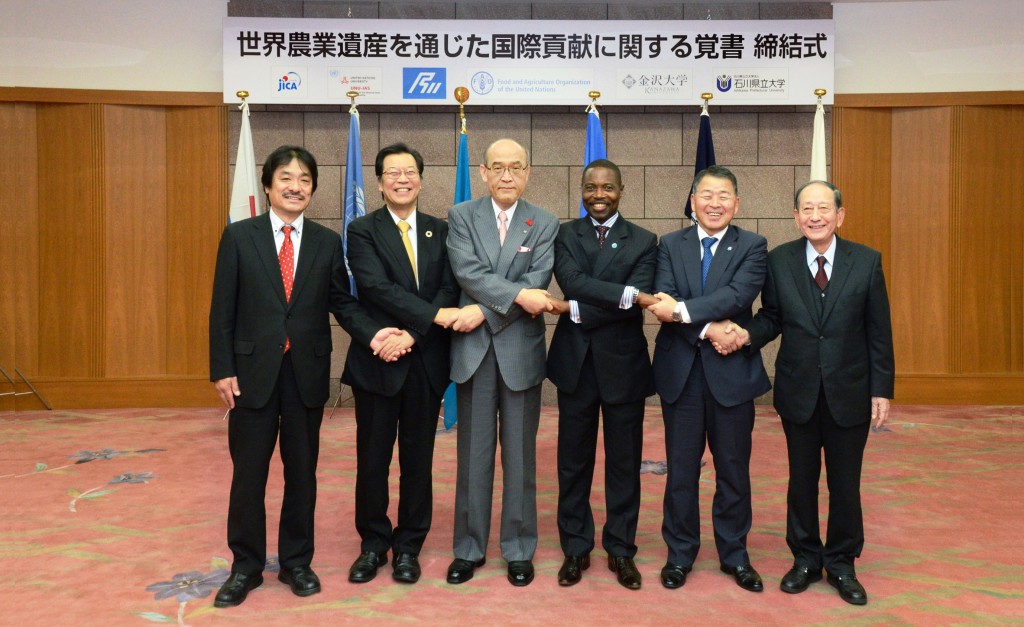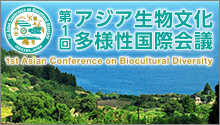1st Asian conference on biocultural diversity:アーカイブ
2018年12月19日
After one year since the 1st Asian Conference on Biocultural Diversity, a series of 2 inernational forums were held to explore the measurements to further promote the Ishikawa Declaration with international initiatives and East Asian partner.
International Forum Series 1 (4/10/2017)
Biocultural diversity & satoyama: Effort towards societies in harmony with nature around the world.
International Forum Series 2 (15/10/2017)
Preserving Biocultural Diversity for Future Generations:Partnarship of East Aisan Countries.
2016年11月01日
It documents discussions and article contributions by speakers who participated in the OUIK Noto Satoumi Lecture Series held in 2015. This lecture series highlighted the Noto Satoumi Movement, which emphasizes local, traditional wisdom of living with the sea, and led in part to the Noto Peninsula’s designation as a Globally Important Agricultural Heritage System (GIAHS) in 2011.
The Noto Satoumi Movement aims to establish the Noto region of Ishikawa Prefecture as a leading center for satoumi research and conservation efforts on the Sea of Japan, as well as to promote a deeper awareness both in and outside of Japan of the concept of Satoumi, the charm of Noto’s satoumi and its related livelihoods, and the importance of satoumi conservation. The booklet is available from here
2016年10月30日
Abstract Book of 1st Asian Conference on Biocultural Diversity Thematic meetings and Poster Presentations
Policies and Actions on Biocultural Diversity for Sustainable Communities
ISBN: 978-92-808-4572-3 [Electronic Version]
*Note: the ISBN and the page number are different from printing version.
2016年05月21日
Japanese / English
2016年02月19日
2024年03月28日
The Noto Peninsula earthquake that occurred on January 1, 2024, caused extensive damage over a wide area, isolating many communities due to landslides that disrupted roads. Additionally, essential lifelines such as water and electricity were interrupted in numerous regions. Particularly in municipalities in the Oku-Noto area and Nanao City, prolonged water supply disruptions have been experienced, with many areas still without water nearly three months after the earthquake.
Amidst this ongoing situation, research associate Koyama has begun an investigation into the use of water sources within the community, including wells and springs.
Through interviews with local residents and on-site surveys, there are plans to explore ways to utilize water for building a resilient community in the face of disasters.
2018年12月26日
In April 2018, OUIK hosted Biocultural walking workshop proposed by Stockholm Resilience Center and IR3S, the University of Tokyo. Prominent international researchers from different continents joined the workshop to experience how biocultural resources could be understood, elaborated and promoted under the current changes occurring urban and rural areas in Japan.
Here is observation by Viveca Mellegård, Stockholm Resilience Center. 「Reinvigorating creative solutions to save people and planet: A walking workshop through biocultural landscapes in western Japan」
2018年12月23日
14th CBD COP has been held in Sharm El-Sheikh, Egypt from 17th -29th November 2018.
UNU-IAS OUIK reported progress of the Ishikawa Declaration, which is approved by the 1st Asian Conference on Buicultural Diversity, at Nature and Culture Summit .
Active dialogue t integrated conservation and local nature and culture as well as to promote rights of indigenous people and local community over the natural resource was exchanges. at the summit.
Mr. Tsunao Watanabe, Director of OUIK presented outcomes from Ishikawa international Cooperation Programm focusing on the capacity building of practitioners for GIAHS promotion, new commons for Japanese garden project by Biocultural Diversity initiative in Kanazawa city.
Presentation materials are available from here.
2017年12月28日
International forum series 2: Preserving biocultural diversity for future generations: partnership of East Asian countries
15 October, 2017, Kanazawa
This forum was co-hosted with Japan committee for IUCN. Together with IUCN committee members and youth participants from Japan, China, and Korea, how to conserve biocultural diversity for future generations was considered.
In the keynote speech, Masahito Yoshida (Professor of University of Tsukuba) gave a lecture on the linkage between nature and culture, including international systems.
At section 1, cases on biocultural diversity in Japan, China, and Korea were introduced. Yoshihiko Iida (OUIK Research Associate) described some activities related to biocultural diversity in Ishikawa and related issues. He pointed out the importance of “diversity” approach to achieve conservation of biocultural diversity through regional initiatives. Xiuling Guan (Director of International Department of Chinese Society of Forestry) presented a case on oak forest management in China and Sun-Kee Hong (Professor of Institution for Marine & Island Cultures, Mokpo National University) advocated the need for a global initiative on island biocultural diversity to achieve sustainable development. Yoshino Ando (Joint Representative of Ramsar Network Japan) introduced their activity to improve biodiversity in rice paddies (Rice-paddy Biodiversity Enhancement Decade).
At Q&A session of section 1, various questions were asked from the audience on topics such as: forest management and conservation method; use of U-shaped gutter or herbicide and biodiversity conservation in rice paddies; building “links” between individual learning; co-existence of nature and livelihood; biocultural diversity and regional revitalization; and issues on legal systems. Participants from Japan, China, and Korea discussed these topics from various viewpoints.
At Q&A session of section 2, youth participants discussed how to make primary industry attractive to young people. Participants pointed out the need for a system which guarantees adequate payment and improving social status. Another participant mentioned the importance for consumers to buy the products considering producing areas and production method. It was also discussed how we could expand our activities to develop links between young people to pass on our nature and culture to future generations.
At the end, Ambassador Masahiko Horie (IUCN Councillor, Special Assistant to the Minister for Foreign Affairs) closed the forum by mentioning the importance of expanding the already existing valuable activities of young people, raising awareness of and mainstreaming biocultural diversity, and building up cohesion and cooperation among global communities.
Field Excursion
Thirty-one participants from Japan, China, and Korea attended the field excursion which was held prior to the forum.
Participants visited Team Maruyama in Wajima and learnt about their activities from the team organizers: Kiichiro Hagino (an architect), and Yuki Hagino (a designer); as well as Koji Ito from Kanazawa University who supports their activity. They outlined their efforts to protect the connection between local tradition, culture, and biodiversity and pass them on to future generations.
Kiichiro Hagino described the reasons why they had moved to Noto and outlined their activities. Yuki Hagino explained how they had arranged the local traditional ritual, Aenokoto, into an original ritual to appreciate biodiversity and how they had been carrying out the ritual every year with a wide variety of participants. She also introduced her original booklets and educational materials such as a seasonal calendar which contains information related to local wisdom, culture, and biodiversity. Koji Ito introduced Satoyama Satoumi Meister Training Program of Kanazawa University which had given the opportunity to start Team Maruyama’s activity, and also about plant monitoring activity which had been carried out by Team Maruyama every month.
Participants were impressed by their inventive programs and educational materials to deliver their messages to general public and children. Participants asked questions enthusiastically, holding and seeing the details of her handmade puppets and booklets. After the visit, some of the participants expressed their interest in starting similar activities in their own countries.
After that, they visited Shiroyone Senmaida (AThousand Rice Paddies) and learnt why these terraced rice paddies had been created in this place and also about the ownership system to protect the landscape of these rice paddies. Participants had a stroll around the Senmaida and fully enjoyed the beautiful landscape of the terraced rice paddies at the seaside.
2017年11月28日
On November 20, 2017, Ishikawa Prefecture, Kanazawa University, Ishikawa Prefectural University, Food and Agriculture Organization of the United Nations (FAO), JICA Hokuriku Branch Office, and the United Nations University Institute for Advanced Study of Sustainability (UNU-IAS) signed a memorandum on ‘International Cooperation Through GIAHS in Ishikawa Prefecture”
‘Noto’s Satoyama and Satoumi’ which stretches over nine municipalities in Noto Peninsula of Ishikawa Prefecture was designated as one of the Globally Important Agricultural Heritage Systems (GIAHS) in 2011 together with Sado Island. They were the first designations from developed countries. Since then, United Nations University has been carrying out various activities together with Ishikawa Prefecture, nine municipalities, and local people of the region. At the GIAHS International Coference 2013 , it was suggested to strengthen the cooperation between the GIAHS in developed countries and those in developing countries by Noto Communiqué. In the following year, 2014, Ishikawa Prefecture established a training program thorough which participants can learn about conservation and utilization of Noto’s Satoyama and Satoumi and its regional development. It has accepted trainees from six different countries so far, including Bhutan, Indonesia, and Laos.
This program has just taken a step further. An international cooperation program was established to bring about mutual-leaning: to enable trainees from developing countries to learn ‘sustainable regional development’ in Noto’s Satoyama and Satoumi on site; and also to enable people in Noto region to realize the global values of sustainability thorough their contribution to this training program. FAO, JICA Hokuriku Branch Office, Kanazawa University, Ishikawa Prefectural University, Ishikawa Prefecture, and UNU-IAS have joined the program as implementing bodies.





